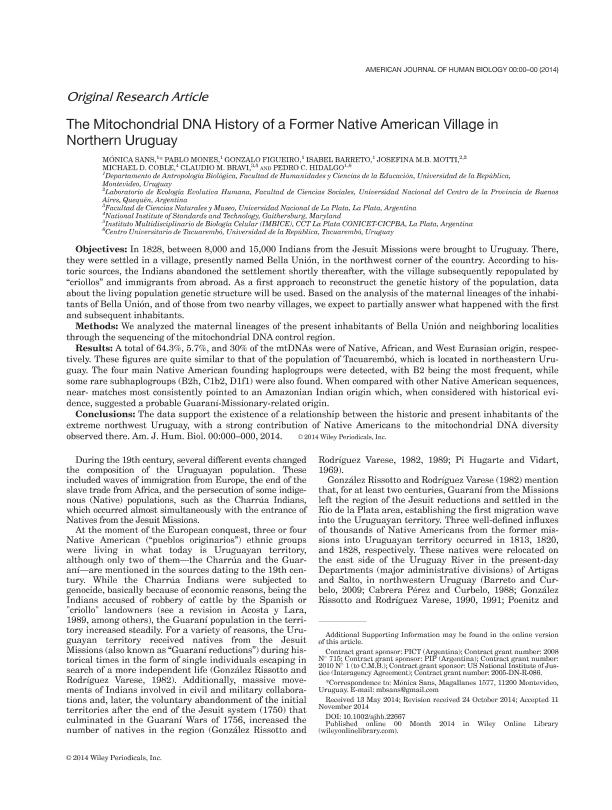Mostrar el registro sencillo del ítem
dc.contributor.author
Sans, Mónica
dc.contributor.author
Mones, Pablo
dc.contributor.author
Figueiro, Gonzalo
dc.contributor.author
Barreto, Isabel
dc.contributor.author
Motti, Josefina María Brenda

dc.contributor.author
Coble, Michael D.
dc.contributor.author
Bravi, Claudio Marcelo

dc.contributor.author
Hidalgo, Pedro C.
dc.date.available
2018-06-29T17:10:58Z
dc.date.issued
2015-05
dc.identifier.citation
Sans, Mónica; Mones, Pablo; Figueiro, Gonzalo; Barreto, Isabel; Motti, Josefina María Brenda; et al.; The mitochondrial DNA history of a former native American village in northern Uruguay; Wiley-liss, Div John Wiley & Sons Inc; American Journal of Human Biology; 27; 3; 5-2015; 407-416
dc.identifier.issn
1042-0533
dc.identifier.uri
http://hdl.handle.net/11336/50674
dc.description.abstract
Objectives: In 1828, between 8,000 and 15,000 Indians from the Jesuit Missions were brought to Uruguay. There, they were settled in a village, presently named Bella Unión, in the northwest corner of the country. According to historic sources, the Indians abandoned the settlement shortly thereafter, with the village subsequently repopulated by "criollos" and immigrants from abroad. As a first approach to reconstruct the genetic history of the population, data about the living population genetic structure will be used. Based on the analysis of the maternal lineages of the inhabitants of Bella Unión, and of those from two nearby villages, we expect to partially answer what happened with the first and subsequent inhabitants. Methods: We analyzed the maternal lineages of the present inhabitants of Bella Unión and neighboring localities through the sequencing of the mitochondrial DNA control region. Results: A total of 64.3%, 5.7%, and 30% of the mtDNAs were of Native, African, and West Eurasian origin, respectively. These figures are quite similar to that of the population of Tacuarembó, which is located in northeastern Uruguay. The four main Native American founding haplogroups were detected, with B2 being the most frequent, while some rare subhaplogroups (B2h, C1b2, D1f1) were also found. When compared with other Native American sequences, near- matches most consistently pointed to an Amazonian Indian origin which, when considered with historical evidence, suggested a probable Guaraní-Missionary-related origin. Conclusions: The data support the existence of a relationship between the historic and present inhabitants of the extreme northwest Uruguay, with a strong contribution of Native Americans to the mitochondrial DNA diversity observed there. Am. J. Hum. Biol. 27:407-416, 2015.
dc.format
application/pdf
dc.language.iso
eng
dc.publisher
Wiley-liss, Div John Wiley & Sons Inc

dc.rights
info:eu-repo/semantics/openAccess
dc.rights.uri
https://creativecommons.org/licenses/by-nc-sa/2.5/ar/
dc.subject
Mitochondrial Dna
dc.subject
Haplotypes
dc.subject
Haplogroups
dc.subject
Native American
dc.subject
Admixture
dc.subject
Uruguay
dc.subject.classification
Otras Ciencias Biológicas

dc.subject.classification
Ciencias Biológicas

dc.subject.classification
CIENCIAS NATURALES Y EXACTAS

dc.title
The mitochondrial DNA history of a former native American village in northern Uruguay
dc.type
info:eu-repo/semantics/article
dc.type
info:ar-repo/semantics/artículo
dc.type
info:eu-repo/semantics/publishedVersion
dc.date.updated
2018-06-29T13:05:05Z
dc.journal.volume
27
dc.journal.number
3
dc.journal.pagination
407-416
dc.journal.pais
Estados Unidos

dc.journal.ciudad
New York
dc.description.fil
Fil: Sans, Mónica. Universidad de la República; Uruguay
dc.description.fil
Fil: Mones, Pablo. Universidad de la República; Uruguay
dc.description.fil
Fil: Figueiro, Gonzalo. Universidad de la República; Uruguay
dc.description.fil
Fil: Barreto, Isabel. Universidad de la República; Uruguay
dc.description.fil
Fil: Motti, Josefina María Brenda. Universidad Nacional del Centro de la Provincia de Buenos Aires. Facultad de Ciencias Sociales. Departamento de Arqueología. Laboratorio de Ecología Evolutiva Humana (Sede Quequén); Argentina. Universidad Nacional de La Plata. Facultad de Ciencias Naturales y Museo; Argentina
dc.description.fil
Fil: Coble, Michael D.. National Institute of Standards and Technology; Estados Unidos
dc.description.fil
Fil: Bravi, Claudio Marcelo. Consejo Nacional de Investigaciones Científicas y Técnicas. Centro Científico Tecnológico Conicet - La Plata. Instituto Multidisciplinario de Biología Celular. Provincia de Buenos Aires. Gobernación. Comisión de Investigaciones Científicas. Instituto Multidisciplinario de Biología Celular. Universidad Nacional de La Plata. Instituto Multidisciplinario de Biología Celular; Argentina. Universidad Nacional de La Plata. Facultad de Ciencias Naturales y Museo; Argentina
dc.description.fil
Fil: Hidalgo, Pedro C.. Universidad de la República; Uruguay
dc.journal.title
American Journal of Human Biology

dc.relation.alternativeid
info:eu-repo/semantics/altIdentifier/doi/https://dx.doi.org/10.1002/ajhb.22667
dc.relation.alternativeid
info:eu-repo/semantics/altIdentifier/url/https://onlinelibrary.wiley.com/doi/abs/10.1002/ajhb.22667
Archivos asociados
